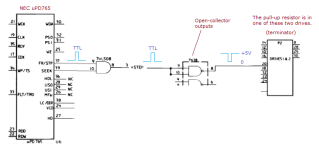Please I have been trying to use the WD1770 FDC for more than a week now without success. I have tried multiple drives and multiple IC's.
The main issue is that when I issue STEP or SEEK commands, and I look at the STEP line on an oscilloscope, it stays around 0V.
I never see the negative pulses that are supposed to come there. I am pulling my hairs trying to understand what I am doing wrong.
I even tried adding a pull up resistor thinking maybe the STEP line is open collector, but it makes no difference.
I am powering the IC from 5V USB, and the floppy drive has its own wall power supply. I thought maybe the grounds were not connected together, but
I am pretty sure they are inside the floppy drive. All the even pon numbers are ground and I assume the drive itself connects the 12V and the 5V grounds together inside it?
But I am not even sure that is the problem. Why, would the STEP line never pulse? I have tried 4 different WD1770 but the behavior is the same.
Please, if you can, give me a hand. Thank you so much!
Paul
The main issue is that when I issue STEP or SEEK commands, and I look at the STEP line on an oscilloscope, it stays around 0V.
I never see the negative pulses that are supposed to come there. I am pulling my hairs trying to understand what I am doing wrong.
I even tried adding a pull up resistor thinking maybe the STEP line is open collector, but it makes no difference.
I am powering the IC from 5V USB, and the floppy drive has its own wall power supply. I thought maybe the grounds were not connected together, but
I am pretty sure they are inside the floppy drive. All the even pon numbers are ground and I assume the drive itself connects the 12V and the 5V grounds together inside it?
But I am not even sure that is the problem. Why, would the STEP line never pulse? I have tried 4 different WD1770 but the behavior is the same.
Please, if you can, give me a hand. Thank you so much!
Paul






